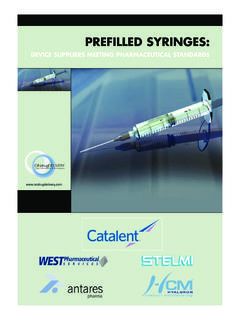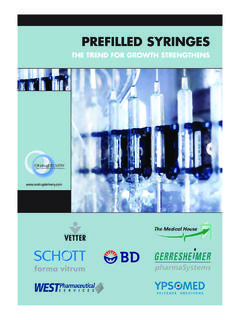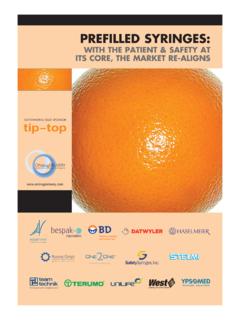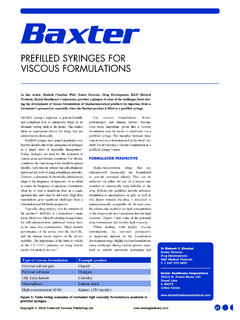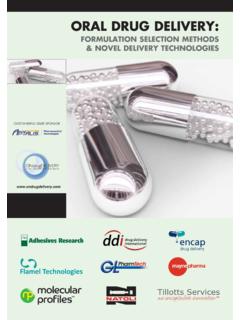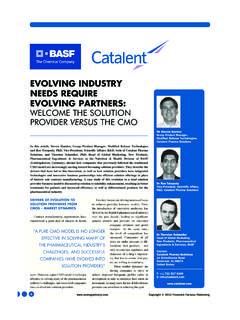Transcription of ADVANCEMENTS IN PREFILLED SYRINGE …
1 Copyright 2012 Frederick Furness Publishing4 Silicone oil is commonly used as a lubricant coating in PREFILLED syringes (PFS) and is becom-ing one of the most highly discussed topics in the PFS market, particularly for developers of highly sensitive biotech drugs. In specific biological drug cases, unexpected drug-container interactions have been reported that were attributed to or associated with sub-visible particles generated from the lubricating silicone layer. Here, Sebastien Jouffray, Core Team Leader, R&D Advanced Product Development, BD Medical Pharmaceutical Systems, describes an innovative immobilised silicone coating: cross-linked silicone, XSiTM. It significantly reduces sub-visible particles while retaining lubrication performance.
2 XSiTM does not introduce any new materials, enabling rapid implementation in PFS for both legacy as well as pipeline IN PREFILLED SYRINGE technology :IMPROVING COMPATIBILITY WITH BIOLOGICS WITH A NOVEL CROSS-LINKED SILICONE COATINGS ebastien JouffrayCore Team Leader, R&D Advanced Product DevelopmentT: +33 476 68 34 57F: +33 476 68 35 05E: Medical - Pharmaceutical Systems11, Rue Aristide-Berges38801 Le Pont de ClaixFranceT: +33 476 68 36 36BD Medical - Pharmaceutical Systems1 Becton DriveFranklin Lakes, NJ 07417 United StatesT: 1 800 225 worldwide PREFILLED SYRINGE market is esti-mated at approximately billion units, with annual growth of around 4-6%.1 PREFILLED syringes provide numerous benefits that explain their steady market growth: minimisation of cross-contamination less waste of valuable drug product resulting from over-filling of traditional syringes elimination of container preparation (vial washing, depyrogenation, preparation of stop-pers and crimp caps) filling line efficiency reduction in medication errors due to fixed dosing streamlined preparation of drug before admin-istration and thus reduced sources for error improved patient compliance added convenience through combination with an auto-injector.
3 The increasing dominance of parenteral drugs, particularly biologics, is another factor in the growth of prefillable syringes . In 2000 just two of the top-20 pharmaceutical products sold in the US were biologicals. By 2016, 10 of the 20 leading US drugs by sales, and seven of the top eight, will be biologicals whose annual sales will top about US$50 billion ( 32 billion).The trend towards self-administration for chronic diseases like multiple sclerosis and rheumatoid arthritis has fuelled growth of more convenient delivery devices such as auto-injectors, pens and others that rely on prefill-ing. Patients prefer the convenience and time savings of PREFILLED devices,2 a factor known to improve adherence to self-administered treat-ment regimens.
4 Since biologics are sensitive molecules, developers need to assess various attributes of the SYRINGE before launch to ensure that the molecule will not interact in an unexpected way with its primary container. The most common SYRINGE characteristics considered are tungsten, rubber, adhesive, silicone, and sub-visible par-ticles (SbVPs).0774_GF_ONdrugDelivery June 2012 Injectable 40774_GF_ONdrugDelivery June 2012 Injectable 406/07/2012 11:2806/07/2012 11:28 Copyright 2011 Frederick Furness Publishing 1: Mechanisms of silicone SbVPs 3: Sub-micron range particles counts of XSiTM, baked silicone and conventionally-lubricated BD syringes . (Particle counting, 200 nm-1 m by Nanosight Ltd. All containers were filled under same conditions: identical buffer solution & stopper).
5 0% 10% 20% 30% 40% 50% 60% 70% 80% 90% 100% XSiBaked SiliconeRegular SiliconeParticles (normalized count / mL) A silicone particles in solutionB silicone surface in contact with drugC silicone unexposed to drugFigure 2: Comparison of unsiliconised, XSiTM, baked silicone and conventionally-lubricated BD syringes . (Normalised particle counting 1-100 m by MFI . All containers were filled under the same conditions: identical buffer solution & stopper).0% 10% 20% 30% 40% 50% 60% 70% 80% 90% 100% No Silicone XSi Baked Silicone Regular Silicone Particles (normalized count / mL) SUB-VISIBLE PARTICLESV isible and sub-visible particle levels are critical to quality attributes of liquid injectables packaged in PREFILLED US FDA s container closure Guidance presents a framework for minimising SbVPs as well as absorption, adsorption, or degradation of active pharmaceutical ingredient, degrada-tion of the container by drug product, and assuring patient A later FDA document addresses SbVPs, particularly their analysis, in greater of SbVPs, defined as particles that cannot be reliably detected by visual inspection with unaided human eye, is continu-ously improved by emerging analytical tech-niques.
6 In particular, the extension of the SbVP size detection limit below 10 m, potentially into the sub-micron range, and the ability to differentiate the nature of those particles will greatly enhance the potential to monitor and report this critical attribute. Such analytical techniques can be used to understand better the contribution of silicone oil, traditionally used as lubricant in PREFILLED syringes , to the overall pool of detected SbVPs. This knowledge will be critical to monitor, control and, if a specific need arises, reduce this three significant populations of silicone-induced SbVPs present in a PREFILLED SYRINGE format are illustrated in Figure SbVPs in a PFS originate from the silicone lubricant applied to the inner SYRINGE surface; three groups are distinct in their formation and potential impact.
7 The first class of silicone droplet (A) is released (or emulsified) into solution soon after filling and is therefore in contact with the drug solution throughout the entire product shelf-life and could be considered for its ability to form silicone-protein complexes. The second type of silicone particle (B) is part of the silicone surface that remains in contact with the drug solution throughout the product shelf life, but may at some point during storage move into solution. The third type (C) is created from the bulk silicone layer sloughed off the wall during injection only. Type C particles are in contact with the drug product for a much shorter time than the other particles types.
8 However, they represent a significant portion of the measured particles with current com-pendial years ago, to address SbVP chal-lenges, BD embarked on a development project to reduce silicone-related SbVPs to their low-est possible levels while retaining syringea-bility and auto-injector functionality,7 as well as managing change control risks. Among the 0774_GF_ONdrugDelivery June 2012 Injectable 50774_GF_ONdrugDelivery June 2012 Injectable 506/07/2012 11:2806/07/2012 11:28 Copyright 2012 Frederick Furness Publishingevaluated technologies were coatings based on new materials such as fluoro-polymers and parylene, a baked silicone process aimed at reducing mechanically active silicone, and an entirely new silicone-based cross-linked coat-ing, BD XSiTM.
9 XSI PERFORMANCE Overall SYRINGE performance depends on several key attributes such as rubber stopper gliding and container inertness with respect to SbVPs. Through internal product design and collaboration with pharmaceutical industry partners, BD has demonstrated that XSiTMtechnology containers achieve superior coat-ing resistance over time compared with previ-ous generations of PREFILLED SYRINGE products, while fulfilling the requirements of an all-new PREFILLED SYRINGE . The benefits of this new technology include: significantly reduced SbVPs compatibility with auto-injectors no new materials in the fluid path comparable extractable / leachable profile to conventional prefillable syringes improved stability with respect to lubricant surface and drugThese advantages relative to conventional spray silicone-based lubrication are covered in the remainder of this section.
10 Particle ReductionThe industrial batch-to-batch analysis of par-ticle-counts measured by HIAC (Hach Company, Loveland, CO, US) relative to commercially avail-able prefillable glass syringes indicates a minimal reduction (in the worst case) of 90%, when baked silicone syringes result in slight SbVP reduction. The trends in observations are even more obvious under stress or shipping conditions. XSiTM SYRINGE is characterised by dramatic reduction of sub-visible particles as shown in Figure 2, which compares regularly siliconised prefillable SYRINGE surface, baked silicone surface, non-siliconised reference surface, and XSiTM. The BD proprietary XSiTM coating does not impede high SYRINGE quality and performance, but mini-mises SbVPs.
